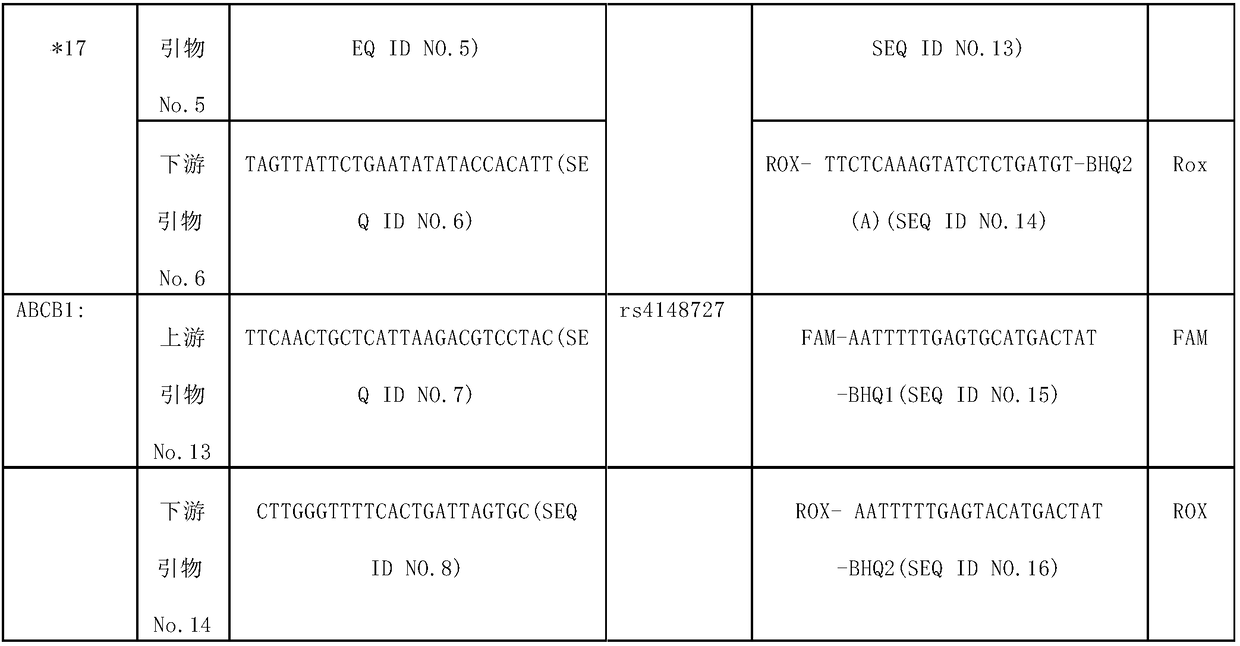Human cytochrome CYP2C19 and ABCB1 gene polymorphism site detection kit and application thereof
A CYP2C19, gene locus technology, applied in the field of biomedicine, can solve the problems of increased risk of embolism re-formation, increased risk of cardiovascular and cerebrovascular events, and increased mortality
- Summary
- Abstract
- Description
- Claims
- Application Information
AI Technical Summary
Problems solved by technology
Method used
Image
Examples
Embodiment 1
[0202] Example 1 Establishment of real-time fluorescent quantitative allele-specific PCR and its clinical evaluation and application
[0203] 1. Establishment of real-time fluorescence quantitative allele-specific PCR method
[0204] Real-time fluorescence quantitative PCR technology has the characteristics of real-time monitoring, quantification and high throughput, and is easy to operate and high in sensitivity. Fluorescent quantitative PCR is divided into probe quantitative PCR (Taqman method) and fluorescent dye quantitative PCR. Probe PCR (Taqman method) refers to adding a specific fluorescent probe while adding a pair of primers during amplification. The probe is an oligonucleotide, and the two ends are respectively labeled with a reporter fluorescent group and a quencher. inactivate the fluorophore. When the probe is intact, the fluorescent signal emitted by the reporter group is absorbed by the quencher group; during PCR amplification, the 5'-3' exonuclease activity ...
Embodiment 2
[0251] Example 2: Detection of CYP2C19*2; CYP2C19*3; CYP2C19*17 and ABCB1 Genotypes by Sequencing
[0252] The current gold standard for gene polymorphism is the sequencing method. In this example, the sequencing method is used to study the distribution of CYP2C19*2; CYP2C19*3; CYP2C19*17 and ABCB1 genes in healthy people. The reliability and accuracy of the method of the present invention are evaluated by comparing with the results obtained by real-time fluorescent quantitative PCR Taqman.
[0253] The sequencing method refers to amplifying the target gene fragment of the sample to be tested by conventional PCR technology, performing sequence determination by the traditional dideoxy method, and comparing with the original sequence, so as to analyze the polymorphic site, which is currently the most common method. Methods used for SNP studies. This method can be used to determine the differences at the molecular level of species at different levels within and between populatio...
Embodiment 3
[0299] This embodiment provides a human cytochrome P450 CYP2C19*2; CYP2C19*3; CYP2C19*17; and ABCB1:rs4148727 genomic single nucleotide polymorphism (SNP) real-time fluorescent quantitative PCR Taqman detection kit.
[0300] This kit can identify and detect CYP2C19*2; CYP2C19*3; CYP2C19*17; and ABCB1:rs4148727 loci in the human genome, and is suitable for the typing of this combined SNP analysis. The kit adopts the principle of fluorescent probe hydrolysis method (Taqman method), including the primer concentration and probe concentration most suitable for real-time fluorescent quantitative PCR reaction, and adopts hot-start Taq DNA polymerase and is most compatible with multiple real-time fluorescent quantitative reactions The unique buffer and primer combination can effectively inhibit non-specific PCR amplification and achieve the purpose of high sensitivity and high throughput real-time fluorescence quantitative PCR amplification reaction. When conducting experiments, the p...
PUM
 Login to View More
Login to View More Abstract
Description
Claims
Application Information
 Login to View More
Login to View More - R&D
- Intellectual Property
- Life Sciences
- Materials
- Tech Scout
- Unparalleled Data Quality
- Higher Quality Content
- 60% Fewer Hallucinations
Browse by: Latest US Patents, China's latest patents, Technical Efficacy Thesaurus, Application Domain, Technology Topic, Popular Technical Reports.
© 2025 PatSnap. All rights reserved.Legal|Privacy policy|Modern Slavery Act Transparency Statement|Sitemap|About US| Contact US: help@patsnap.com



